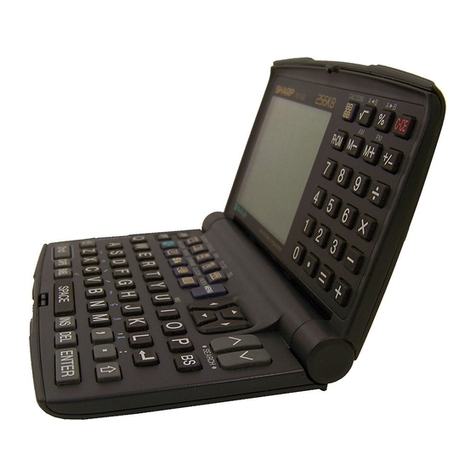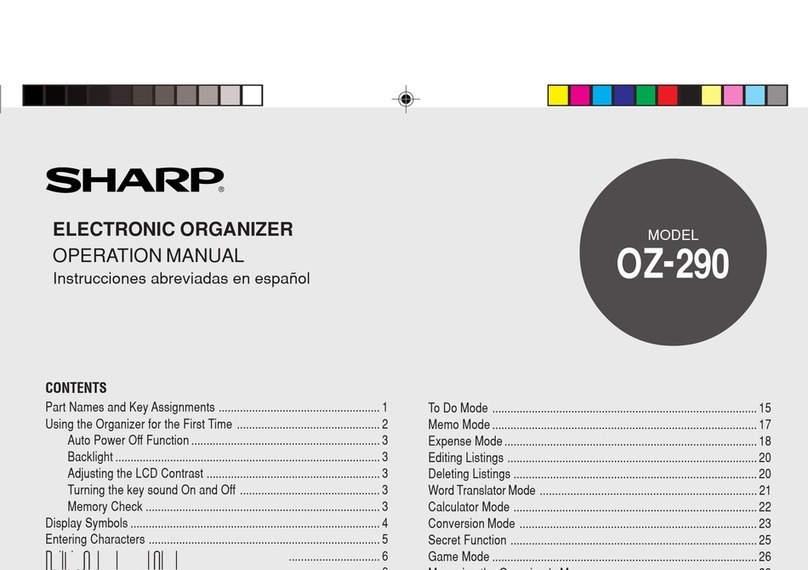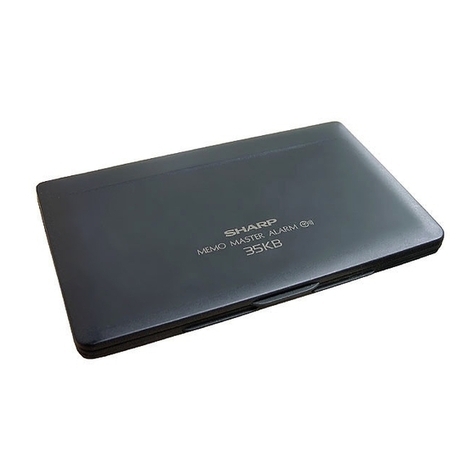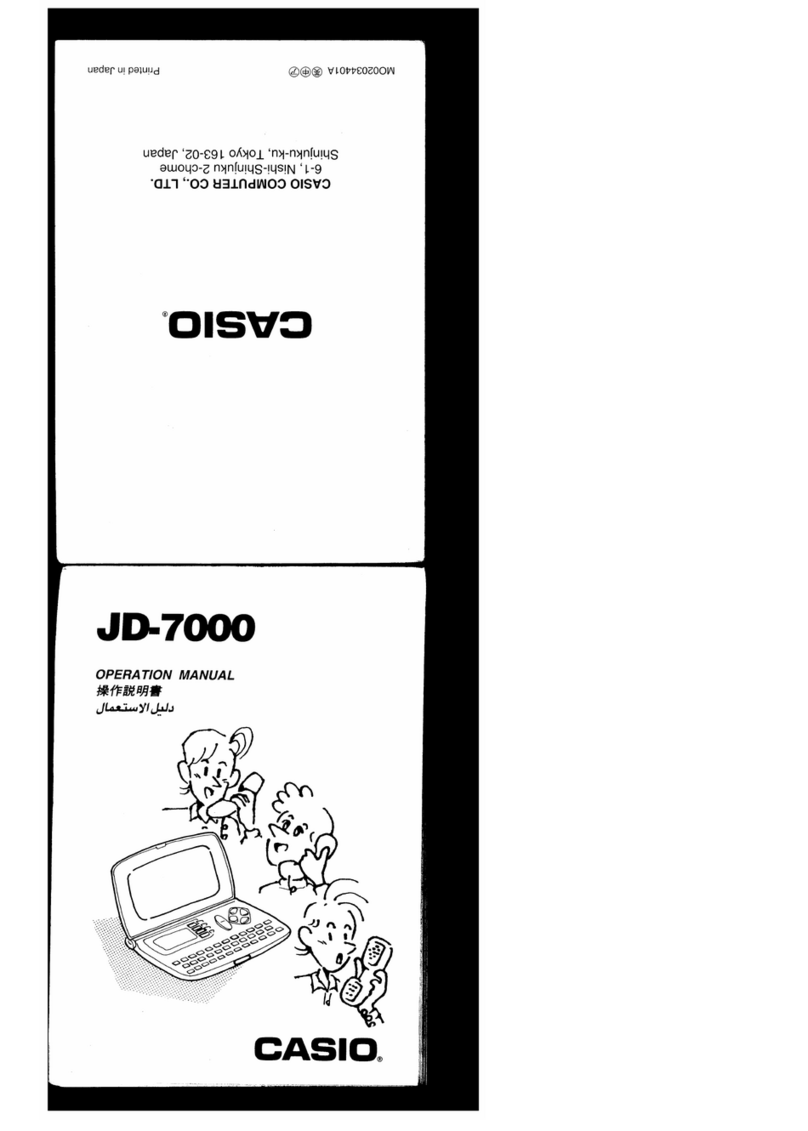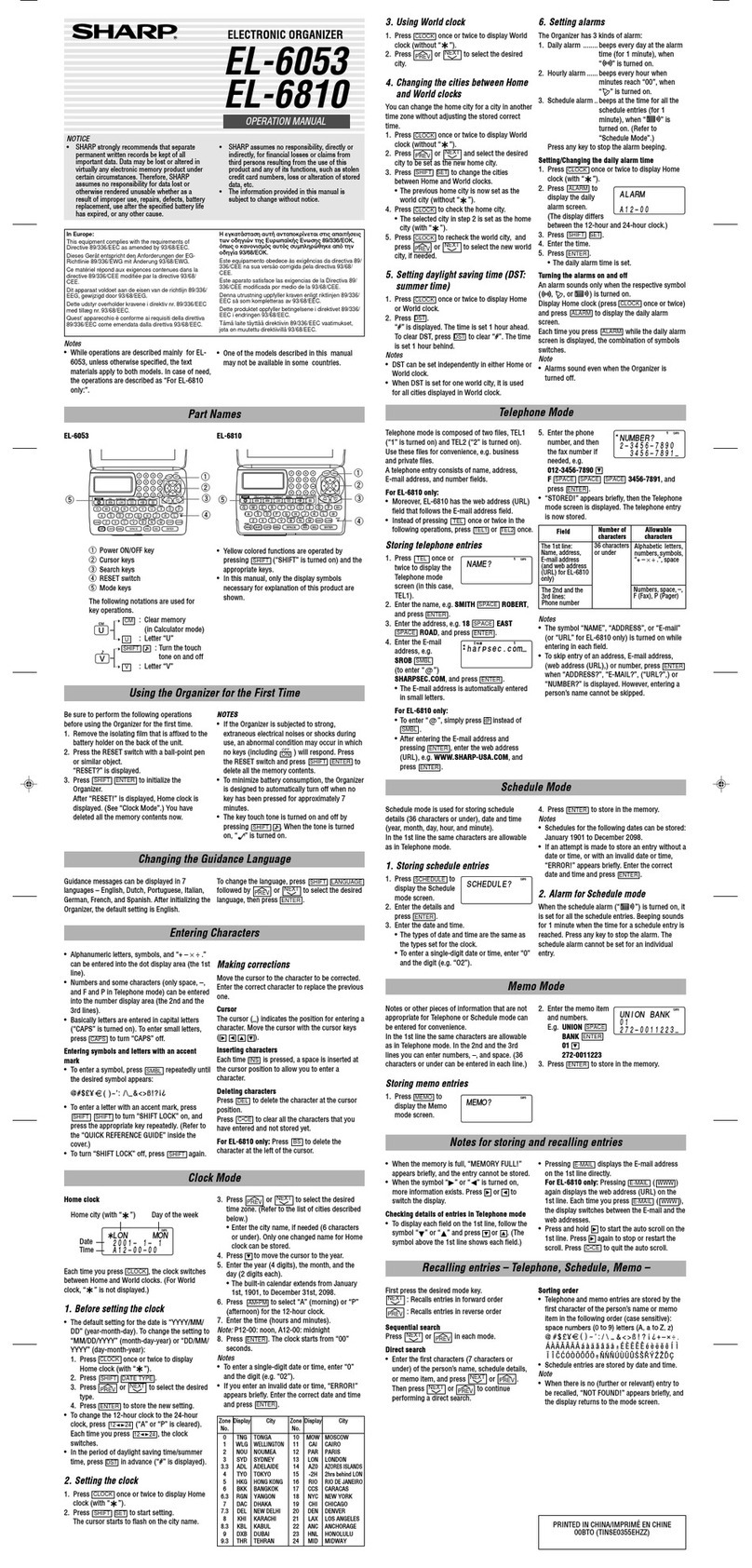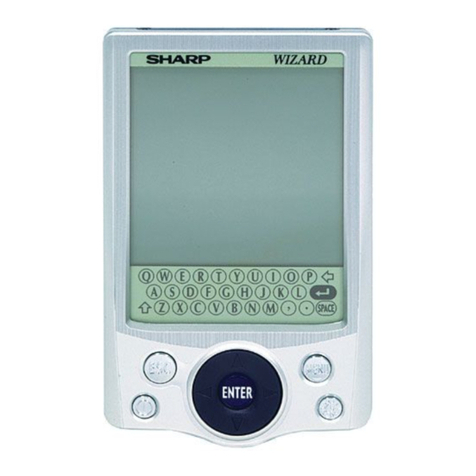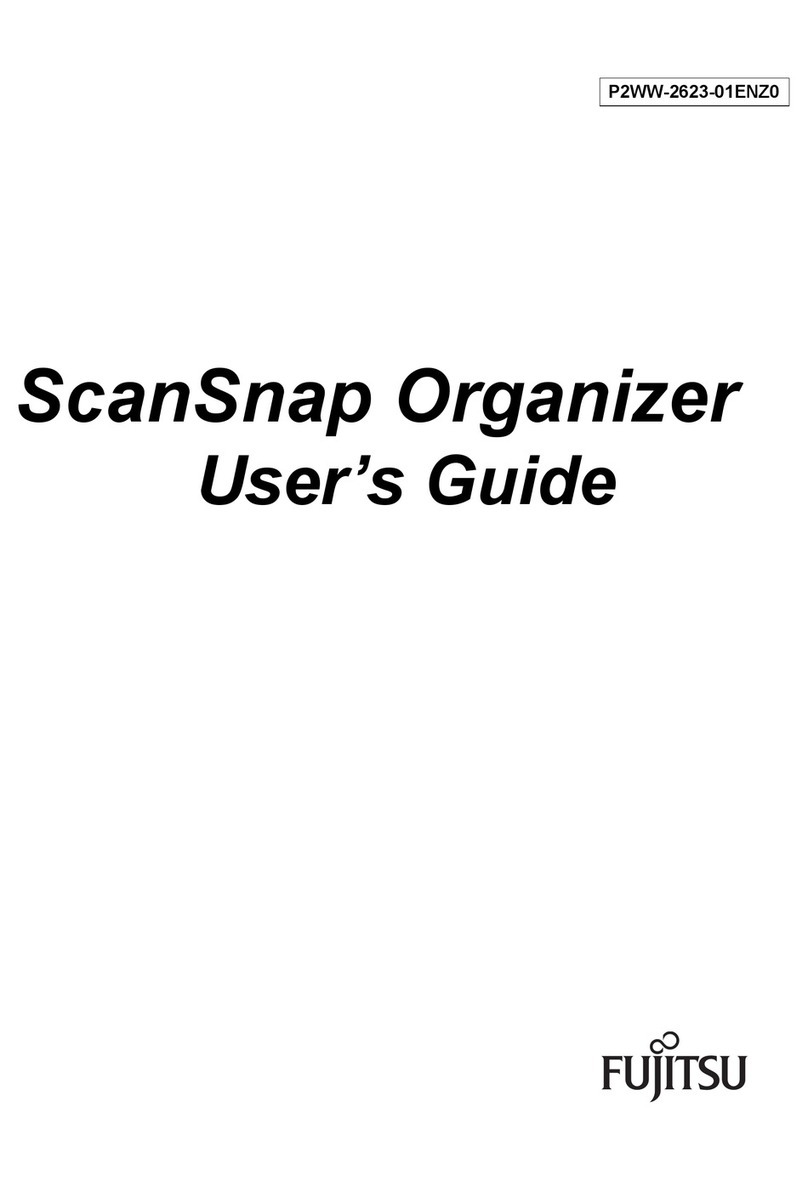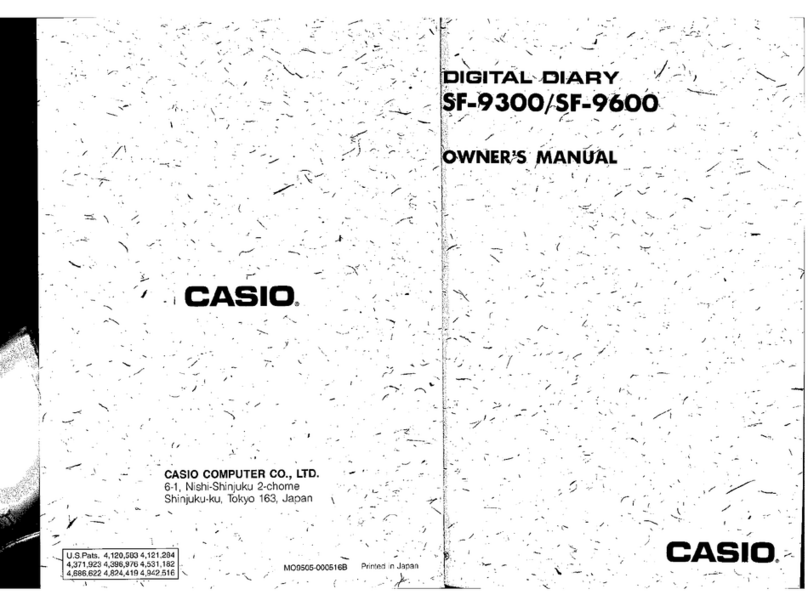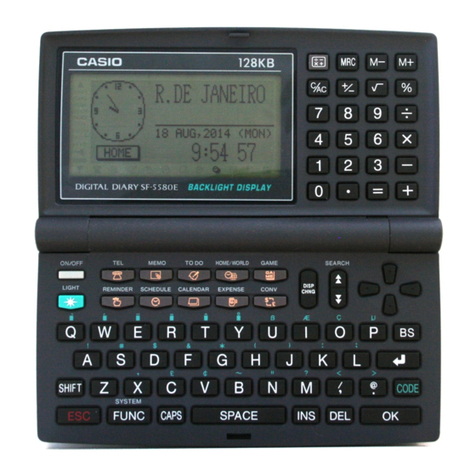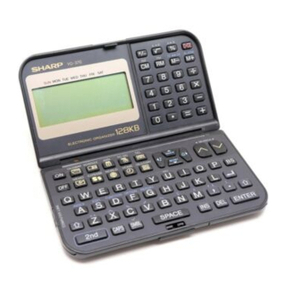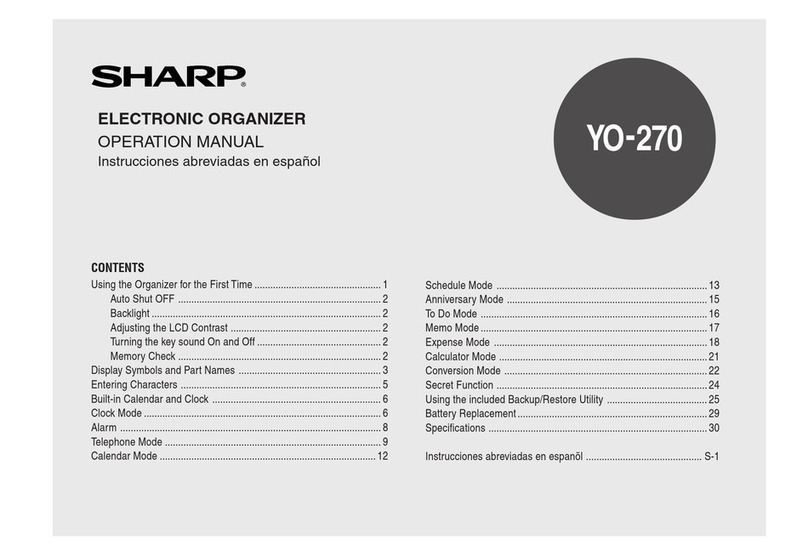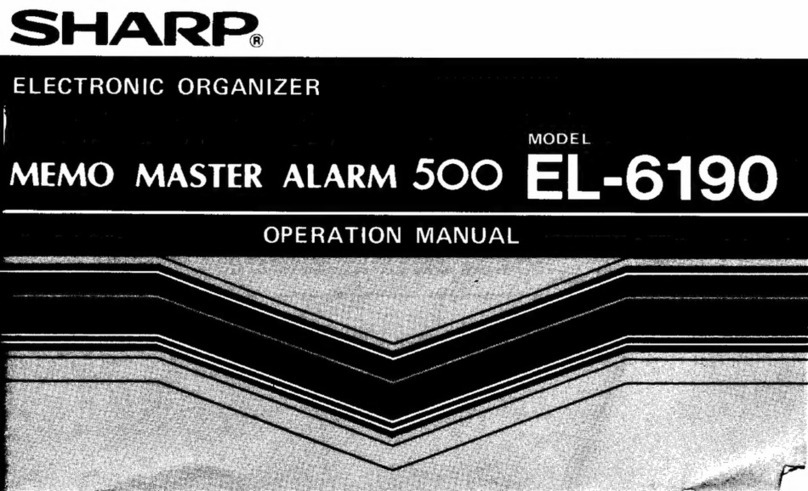IDEC WindO/I-NV4 User manual

B-1701(16)
User’s Manual

SAFETY PRECAUTIONS
Preface-1 WindO/I-NV4 User’s Manual
Confirm that the delivered product is what you have ordered. Read this manual to make sure of correct operation.
• Be certain to read this manual carefully before performing installation, wiring, or maintenance work, or operating
the HG2J-7U,HG5G/4G/3G/2G-V, HG4G/3G, HG2G-5F/-5T, HG1G/1P (Hereinafter referred to as "MICRO/I").
• The MICRO/I has been manufactured with careful regard to quality. However, if you intend to use this product in
applications where failure of this equipment may result in damage to property or injury, ensure that it used in
conjunction with appropriate fail-safe backup equipment.
• Precautionary measure should be taken to avoid unauthorized access from the outside network to the MICRO/I.
Please note that the Company shall not be liable for any loss, damage or other expenses incurred directly or
indirectly by unauthorized access, etc.
• In this manual, safety precautions are categorized depending on the severity as Warning or Caution:
SAFETY PRECAUTIONS
Warning notices are used to emphasize that improper operation may cause severe
personal injury or death.
Caution notices are used where inattention might cause personal injury or damage to
equipment.
MICRO/I (Common to all models):
• The MICRO/I is not designed for use in applications requiring a high degree of reliability and safety, such as
applications for medical devices, nuclear power, railroads, aerospace, and automotive devices. The MICRO/I
should not be used for such applications.
• Turn off the power of the MICRO/I before installation, removal, wiring, maintenance, and inspection of the
MICRO/I. Failure to turn power off may cause electrical shock or fire hazard.
• Special expertise is required to install, wire, configure, and operate the MICRO/I. Person without such expertise
must not use the MICRO/I.
• The MICRO/I uses an LCD (liquid crystal display) as a display device. The liquid inside the LCD is harmful to the
skin. If the LCD is broken and the liquid attaches to your skin or clothing, wash the liquid off using soap, and
consult a doctor immediately.
• An emergency circuit that uses emergency stop switch must be configured outside of the MICRO/I.
• Do not use touch switches, the function keys and selector switches for an emergency circuit or an interlocking
circuit. If the MICRO/I fails, equipment connected to the MICRO/I will no longer be protected, and serious injury
to operators and equipment damage may be caused.
• In case the MICRO/I is accidentally dropped or exposed to significant shock, stop using the MICRO/I, check the
MICRO/I for damage, and confirm that its various functions work safely and correctly.
• Connect MICRO/I's FG wire to grounding resistance of 100 Ω or less. Otherwise, there is a risk of electric shock
or malfunction.
• The screen will not be visible if the backlight of the MICRO/I burns out. However, the touch panel and the function
keys will remain functional. Thus, Erroneous touch panel operation or function key operation may occur while
controlling the touch panel. Because such erroneous operations could result in damage, the touch panel and the
function key should not be used once the backlight is burned out.
HG5G/4G/3G/2G-V, HG4G/3G, HG2G-5F/-5T, HG1G/1P:
• When more than one panel spot is pressed at the same time, due to the detection mechanism of the analog type
touch panel used in the main unit, the unit assumes that only the center of the pressed spots is sensed and the
unit assumes that only one button is pressed. Therefore, do not operate the MICRO/I by pressing more than one
button simultaneously.
HG1P:
• For the emergency stop switch and the enabling switch on the main unit, note the following points:
- Connect the emergency stop switch to function as either a category 0 or category 1 stop in accordance with EN60204-1.
- Perform regular checks to confirm that the emergency stop switch and enabling switch work properly. It is extremely
dangerous if the enabling switch no longer returns to position 1 due to a foreign object getting stuck in the switch.
- Do not, under any circumstances, hold the enabling switch in position 2 with tape, string, or deform the rubber
cover. The function of the enabling switch will be lost, and the enabling switch may not work in an emergency.
- Place your finger firmly on the enabling switch.
• The emergency stop function is disabled when main unit is removed from the machine. To eliminate the
possibility of accidents caused by operating the disabled emergency stop switch, place the main unit, removed
from the machine, in a location that is not visible to the operator. Install at least one emergency stop switch on
the machine near the location where the HG1P is connected.

WindO/I-NV4 User’s Manual Preface-2
SAFETY PRECAUTIONS
MICRO/I (Common to all models):
• Prevent the MICRO/I from falling while moving or transporting, otherwise it may cause damage or malfunction to
the MICRO/I as a result.
• Use the product within the environmental limits given in the catalog and manual. Use of the product in high-
temperature or high-humidity environments, or in locations where it is exposed to condensation, corrosive gas,
or large shock loads can create the risk of electrocution and fire.
• The MICRO/I is designed for use in pollution degree 2. Use the MICRO/I in environments of pollution degree 2.
(based on the IEC60664-1 rating)
• Install the MICRO/I according to the instructions. Improper installation will result in falling, failure, electrical
shock, fire hazard, or malfunction of the MICRO/I.
• Prevent metal fragments or wire chips from dropping inside the MICRO/I housing. Ingress of such fragments
and chips may cause fire hazard, damage, and malfunction.
• Use a power supply of the rated value. Using a wrong power supply may cause fire hazard.
• When exporting the MICRO/I to Europe, use an EN60127 (IEC60127) approved fuse on the power line outside
the MICRO/I.
• When exporting the MICRO/I to Europe, use an EU-approved circuit protector.
• Make sure of safety before starting and stopping the MICRO/I. Incorrect operation of the MICRO/I may cause
mechanical damage or accidents.
• The touch panel of the MICRO/I is made of glass, and will break if exposed to excessive shock. Take due care
when handling it.
• The protective film attached to the display of the MICRO/I is to protect the product from scratches during
transportation. Please remove the protective film before use. If the display is used with protective film, the film
may become cloudy and stick to the display depending on the usage environment and may become unremovable.
• Do not push hard or scratch the touch panel and protection sheet with a hard object like hand tool. Touch panel
and protection sheet can be easily damaged.
• Do not install the MICRO/I in areas subjected to strong ultraviolet rays, since ultraviolet rays may impair the
quality of the LCD.
• Do not attempt to disassemble, repair or modify the MICRO/I. This can create the risk of fire or electrocution.
• When disposing of the MICRO/I, do so as an industrial waste.
• Do not switch off the power or pull out the SD Memory Card or the USB flash drive while it is being accessed, as
this may result in destruction of the stored data. If the data on the SD Memory Card or the USB flash drive is
corrupted, format the SD Memory Card or the USB flash drive.
• Turn off the power supply of the MICRO/I before connecting or disconnecting USB devices other than USB memory.
HG2J-7U:
• The main unit uses “PS2 of EN61131” as DC power supply. (based on the IEC/EN61131 rating)
• Use wire of a proper size to meet the voltage and current requirements.
HG5G/4G/3G/2G-V, HG4G/3G, HG2G-5F/-5T, HG1G/1P:
• There is no function to correct the time. Do not use device beyond the rated operating temperature, otherwise
the clock accuracy will be affected.
HG5G/4G/3G/2G-V, HG4G/3G, HG2G-5F/-5T, HG1G:
• The main unit uses “PS2 of EN61131” as DC power supply. (based on the IEC/EN61131 rating) Use wire of a
proper size to meet the voltage and current requirements, and tighten the terminal screws of the main unit to
the specified tightening torque.
HG5G/4G/3G/2G-V, HG4G/3G, HG2G-5F:
• Be sure to confirm that the SD Memory Card Access lamp is not lit prior to turning the power off to the main unit
or pulling out the SD memory card. Refer to this manual for details.
HG1P:
• Use the HG1P optional cable for proper wiring.
• The D-sub connector on the end of the HG1P optional cable is not water- or dust-proof. If protection against
water and dust is required, the user must replace the D-sub connector with a water-proof connector.

Revision history
Preface-3 WindO/I-NV4 User’s Manual
Revision history
Caution
• The contents of this manual and the WindO/I-NV4 application are copyright, and all rights are reserved by IDEC
Corporation. Unauthorized reproduction is prohibited.
• The contents of this manual and the WindO/I-NV4 application are subject to change without notice.
• IDEC Corporation accepts no responsibility for circumstances arising from the use of this manual or the
WindO/I-NV4 application.
• Please contact your vendor or IDEC Corporation with any problems regarding the operation of this product.
• This product cannot be directly connected to the communication lines (including public wireless LAN) of
telecommunication carriers (mobile communication companies, fixed-line communication companies, Internet
providers, etc.). When connecting this product to the Internet, be sure to connect via a device, such as a router.
Trademarks
WindO/I and MICRO/I are registered trademarks of IDEC CORPORATION in JAPAN. Microsoft and Windows are either
registered trademarks or trademarks of Microsoft Corporation in the United States and/or other countries. Adobe is a
trademark of Adobe Systems Incorporated.
All other company names and product names used in this manual or the WindO/I-NV4 application are trademarks of
their respective owners.
This product adopts the font of Ryobi.
August 2015: First Edition
May 2016: Second Edition
July 2016: Third Edition
November 2016: Fourth Edition
March 2017: Fifth Edition
June 2017: Sixth Edition
August 2017: Seventh Edition
December 2017: Eighth Edition
March 2018: Ninth Edition
June 2018: Tenth Edition
March 2019: Eleventh Edition
May 2019: Twelfth Edition
December 2019: Thirteenth Edition
July 2020: Fourteenth Edition
December 2020: Fifteenth Edition
March 2021: Sixteenth Edition
January 2022: Seventeenth Edition

WindO/I-NV4 User’s Manual Preface-4
Preface
Preface
This manual describes MICRO/I operator interfaces (HG2J-7U, HG5G/4G/3G/2G-V, HG4G/3G, HG2G-5F/-5T, HG1G/
1P) and WindO/I-NV4 general configuration software. The information includes drawing tools, setup procedures, and
how to configure all MICRO/I operator interfaces.
This manual explains the operation and handling of the MICRO/I HG2J-7U, HG5G/4G/3G/2G-V, HG4G/3G, HG2G-5F/-
5T, HG1G/1P. Please read it carefully and ensure that you fully understand the functions and performance of the
MICRO/I HG2J-7U, HG5G/4G/3G/2G-V, HG4G/3G, HG2G-5F/-5T, HG1G/1P and the WindO/I-NV4 configuration
software.
Read the following materials as necessary for your particular application.
References Content
WindO/I-NV4 User's Manual
(This document)
Describes the hardware specifications of the HG2J-7U, HG5G/4G/3G/2G-V,
HG4G/3G, HG2G-5F/-5T, HG1G/1P.
WindO/I-NV4 External Device Setup
Manual (PDF)
Describes the connection procedures and available device addresses for various
communication including the Device Link Communication, O/I Link
communication, and DM Link communication.
WindO/I-NV4 Help Describes the operating procedures. The user is allowed to view all manuals via
Help.
Character Table (PDF)
A list of fonts can be used with the HG2J-7U, HG5G/4G/3G/2G-V, HG4G/3G,
HG2G-5F/-5T, HG1G/1P and WindO/I-NV4. For restrictions on using the HG2J-
7U, HG5G/4G/3G/2G-V, HG4G/3G, HG2G-5F/-5T, HG1G/1P, refer to Chapter 2
“1.2 Available Text” on page 2-6.

Symbols Used in this Manual
Preface-5 WindO/I-NV4 User’s Manual
Symbols Used in this Manual
This manual uses the following symbols to facilitate explanation.
Symbols
…… Information that requires special attention. Failure to operate the product in accordance
with the information provided can lead to serious injury or damage.
…… Information relating to requests or material to reference in the use of a function
…… Useful information relating to a function
…… Indicates the chapter and page of related reference information.
OK …… Screen buttons are indicated by bold text or by using the actual graphic icon.
SHIFT, …… Keyboard keys are indicated by the keyboard inscription in capital letters or enclosed in
square brackets.
**** …… Controls are indicated by bold text.
A

WindO/I-NV4 User’s Manual Preface-6
Abbreviations, Generic Terms, and Terminology Used in this Manual
Abbreviations, Generic Terms, and Terminology Used in this Manual
Item Description
HG2J-7U The name is short for MICRO/I HG2J-7UT22TF-B.
HG5G-V The name is short for MICRO/I HG5G-VFXT22MF-B.
HG4G-V The name is short for MICRO/I HG4G-VCXT22MF-B.
HG4G The name is short for MICRO/I HG4G-CJT22*F-B.
HG3G-V The name is short for MICRO/I HG3G-V*XT22MF-*.
HG3G The name is short for MICRO/I HG3G-*JT22*F-*.
HG2G-V The name is short for MICRO/I HG2G-V5FT22TF-*.
HG2G-5F The name is short for MICRO/I HG2G-5FT22TF-*.
HG2G-5T The name is short for MICRO/I HG2G-5T*22TF-*.
HG1G The name is short for MICRO/I HG1G-4VT22TF-*.
HG1P The name is short for MICRO/I HG1P-ST32*.
HG5G/4G/3G/2G-V The format used to refer to HG5G-V, HG4G-V, HG3G-V and HG2G-V.
HG5G/4G/3G-V The format used to refer to HG5G-V, HG4G-V and HG3G-V.
HG4G/3G The format used to refer to HG4G and HG3G. HG4G-V and HG3G-V is not included.
HG2G-5F/-5T The format used to refer to HG2G-5F and HG2G-5T.
HG1G/1P The format used to refer to HG1G and HG1P.
MICRO/I Generic term used to refer to the HG2J-7U, HG5G/4G/3G/2G-V, HG4G/3G, HG2G-5F/-5T,
HG1G/1P.
External Device Generic term used to refer to a PLC or micro computer that is connected to and
communicates with the MICRO/I.
Device Address Memory that is capable of storing values in unit of bits or words loaded on the MICRO/I
and external device.
System Area Device address area that is pre-allocated for exchanging screen management, error
information, and clock data between the MICRO/I and an external device.
Device Link Communication A communication method that performs communication with the external device
according to the setting of the screen and without a program.
DM Link Communication A communication method that reads to or writes value to external devices using the
MICRO/I's dedicated DM Link memory.
User Communication A communication method which performs communication with external devices such as
barcode readers and inverters.
External Device Communication Generic term used to refer to Device Link Communication and DM Link Communication.
Sub Host Communication A communication method that performs communication with external device according
to the set device address list and without a program.
BACnet Communication A communication method for building management systems such as air conditioning,
lighting and crime prevention.
O/I Link A connection format that enables connections of up to 16 units of MICRO/I with high-
speed communication of 115,200bps.
O/I Link Master The MICRO/I unit that is directly connected to external device on the O/I Link network.
O/I Link Slave The MICRO/I units that are not directly connected to external device on the O/I Link
network.
WindO/I-NV4 Integrated configuration software application for creating projects of the MICRO/I.
Operating System Software used to manage and control system software. Only HG2J-7U supports the update.
System Software Software required for operating MICRO/I.
Project Data including image data required for operating the MICRO/I, which is created with
WindO/I-NV4.
Manager WindO/I-NV4 provides tools to manage pictures, text and script etc. With the Managers,
you can create and manage them in your project.
Setup Generic term used to refer to the common settings in the project.

Abbreviations, Generic Terms, and Terminology Used in this Manual
Preface-7 WindO/I-NV4 User’s Manual
Project Settings Basic settings of operation in the Setup settings.
Alarm Log A function where the MICRO/I collects log data of alarms.
Data Log A function where the MICRO/I collects value of device addresses.
Script A script is an executable list of commands created by a simple programming language.
Text Group A group of 32 texts maximum that is in order to dynamically switch the character
displayed on the MICRO/I according to the value of the device address.
Windows Font A character font that can be used on a computer running WindO/I-NV4.
Stroke Font
A glyph's outline is defined by the vertices of individual strokes and stroke's profile.
Scalable fonts scale easily without jagged edges.
Under font settings, “Stroke” is a stroke-based font.
Maintenance Communication Communications between the WindO/I-NV4 and MICRO/I using a dedicated protocol.
Device Monitor A special Popup Screen on the MICRO/I on which value of the device address can be
displayed or changed.
Pass-Through A function that enables maintenance of the external device via the MICRO/I.
System Screen Pre-allocated screen dedicated for performing initial setting of the MICRO/I,
self-diagnosis, and clearing the log data etc.
External Memory Device The generic term for an SD memory card and a USB flash drive.
NV Metafile A graphic data file that integrates drawings created on the WindO/I-NV4 edit screen.
Window Screens that are loaded on to the Base Screen, including Popup Screen and Device
Monitor.
Internal Device The generic term for internal device addressing on the MICRO/I such as internal relays,
registers, etc.
Keep Device
The generic term for internal device not initialized at the start of operation. Even after
the power is turned off, the values are retained by the battery.
• HMI Keep Registers (LKR)
• HMI Keep Relays (LK)
Drawings Define as as non functional content (i.e. shape, picture, text).
Parts Define as functional content (i.e. button, pilot lamp, commands, etc.)
Object Define as combination of Drawings and Parts placed on WindO/I-NV4 edit screen.
Touch Switch A part that operates a function by pressing parts that have been placed on the screen.
Standard Keypad
Keypad that is displayed when operating Numerical and Character Input parts when
Standard is selected under Type in the Keypad menu for Numerical and Character
Input parts.
Movie File List It is a list of movie files that have been registered in the Multimedia Function settings.
You cannot change the order when you play files.
Item Description

Contents
WindO/I-NV4 User’s Manual Preface-8
SAFETY PRECAUTIONS ................................................................................ Preface-1
Revision history ........................................................................................... Preface-3
Caution ....................................................................................................... Preface-3
Trademarks................................................................................................. Preface-3
Preface ....................................................................................................... Preface-4
Symbols Used in this Manual ........................................................................ Preface-5
Abbreviations, Generic Terms, and Terminology Used in this Manual ............... Preface-6
Chapter 1 System Composition
1 System Composition.............................................................................................. 1-1
1.1 System Composition for the RUN operation.......................................................1-1
1.2 System Composition for Creating Screens .........................................................1-2
2 About the WindO/I-NV4 ........................................................................................ 1-3
3 Operating Modes .................................................................................................. 1-4
4 Flow from Screen Creation and to Run Operation .................................................... 1-5
Chapter 2 WindO/I-NV4 Features & Basic Operations
1 WindO/I-NV4 Specifications ................................................................................... 2-1
1.1 Available Data.................................................................................................2-1
1.2 Available Text .................................................................................................2-6
1.3 Available Number of Colors ............................................................................2-20
1.4 Available Image Files.....................................................................................2-20
1.5 Available Sound Files.....................................................................................2-37
1.6 Available Movie Files .....................................................................................2-37
2 Starting and Exiting WindO/I-NV4 ........................................................................ 2-38
2.1 Starting WindO/I-NV4....................................................................................2-38
2.2 Exiting WindO/I-NV4 .....................................................................................2-40
3 Configuration & Functions ................................................................................... 2-41
3.1 Application Menu Command List.....................................................................2-42
3.2 Quick Access Toolbar.....................................................................................2-43
3.3 Ribbon Command List....................................................................................2-46
3.4 Windows Displayed in the Workspace.............................................................2-55
3.5 Status Bar ....................................................................................................2-58
4 Customizing WindO/I-NV4 ................................................................................... 2-61
4.1 Configuring the Work Environment.................................................................2-61
4.2 Customizing the Workspace ...........................................................................2-69
5 WindO/I-NV4 Common Operations and Settings.................................................... 2-70
5.1 Device Address Settings.................................................................................2-70
5.2 Setting Conditional Expressions......................................................................2-73
Contents

Contents
Preface-9 WindO/I-NV4 User’s Manual
Chapter 3 Communication
1 Device Link Communication....................................................................................3-1
1.1 Overview ....................................................................................................... 3-1
1.2 Device Link Communication Settings................................................................ 3-2
2 O/I Link Communication.........................................................................................3-3
2.1 Overview ....................................................................................................... 3-3
2.2 O/I Link Communication Settings..................................................................... 3-3
3 DM Link Communication.........................................................................................3-4
3.1 Overview ....................................................................................................... 3-4
3.2 DM Link Communication Settings..................................................................... 3-6
4 No External Devices...............................................................................................3-7
4.1 Overview ....................................................................................................... 3-7
4.2 No External Devices Settings........................................................................... 3-7
5 User Communication..............................................................................................3-8
5.1 Overview ....................................................................................................... 3-8
5.2 User Communication Settings Procedure .......................................................... 3-9
5.3 Protocol Manager ..........................................................................................3-32
5.4 Example of User Communication Settings........................................................3-80
5.5 Connection Diagram for User Communication..................................................3-86
6 Sub Host Communication .....................................................................................3-87
6.1 Overview ......................................................................................................3-87
6.2 Supported Protocols and Communication Driver...............................................3-87
6.3 HMI Link Register (LLR) Assignment ...............................................................3-88
6.4 Sub Host Communication Configuration Procedure...........................................3-89
6.5 Error Information ..........................................................................................3-92
7 BACnet Communication........................................................................................3-94
7.1 Overview ......................................................................................................3-94
7.2 BACnet Specifications ....................................................................................3-95
7.3 About BACnet ...............................................................................................3-96
7.4 Function .......................................................................................................3-98
7.5 BACnet/IP Operation ...................................................................................3-104
7.6 BACnet/IP Settings Procedure ......................................................................3-105
7.7 BACnet Settings Dialog Box..........................................................................3-108
7.8 Objects.......................................................................................................3-124
7.9 Key Properties.............................................................................................3-132
Chapter 4 Project Settings
1 Creating and Manipulating WindO/I-NV4 Project Data ..............................................4-1
1.1 Creating New Project Data .............................................................................. 4-1
1.2 Opening Project Data ..................................................................................... 4-4
1.3 Saving Project Data........................................................................................ 4-5
1.4 Printing Project Data ...................................................................................... 4-7
1.5 Comparing Project Data.................................................................................4-18
1.6 Changing Project Settings ..............................................................................4-19
1.7 Closing Project Data ......................................................................................4-23
2 Project Settings Configuration Procedure...............................................................4-24

Contents
WindO/I-NV4 User’s Manual Preface-10
3 Project Settings Dialog Box.................................................................................. 4-25
3.1 System Tab ..................................................................................................4-25
3.2 Communication Interface Tab ........................................................................4-35
3.3 Communication Driver Tab.............................................................................4-47
3.4 Communication Driver Network Tab ...............................................................4-52
3.5 O/I Link Tab .................................................................................................4-55
3.6 User Communication Tab...............................................................................4-56
3.7 Sub Host Communication Tab ........................................................................4-60
3.8 Printer Tab ...................................................................................................4-62
3.9 External Memory Device Tab..........................................................................4-63
3.10 Autorun Tab .................................................................................................4-64
3.11 Expansion Module Tab...................................................................................4-65
3.12 Web Server Tab ............................................................................................4-66
3.13 FTP Server Tab .............................................................................................4-68
3.14 E-mail Tab....................................................................................................4-70
3.15 Project Details Tab........................................................................................4-75
3.16 Font/Kanji Dictionary Data Tab.......................................................................4-76
3.17 Compatible Tab.............................................................................................4-77
3.18 BACnet/IP Settings Tab .................................................................................4-80
3.19 Internal Clock Tab.........................................................................................4-81
4 Project Restrictions ............................................................................................. 4-83
4.1 Download Restrictions ...................................................................................4-83
4.2 Maximum Number of External Device Addresses..............................................4-83
Chapter 5 Screen
1 Screen Overview................................................................................................... 5-1
1.1 Screen Types..................................................................................................5-1
1.2 Screen Size.....................................................................................................5-1
2 Creating and Manipulating WindO/I-NV4 Screens .................................................... 5-2
2.1 Creating Screens.............................................................................................5-2
2.2 Opening Screens.............................................................................................5-3
2.3 Closing Screens...............................................................................................5-5
2.4 Duplicating Screens.........................................................................................5-7
2.5 Deleting Screens .............................................................................................5-9
2.6 Reusing Screens............................................................................................5-11
2.7 Batch Editing of Multiple Screen Settings ........................................................5-13
3 Base Screen ....................................................................................................... 5-14
3.1 Properties of Base Screen Dialog Box..............................................................5-14
3.2 Displaying Layered Base Screens....................................................................5-18
4 Popup Screen ..................................................................................................... 5-20
4.1 Properties of Popup Screen Dialog Box ...........................................................5-20
4.2 Popup Screen Configuration...........................................................................5-24
4.3 Standard Keypad Popup Screen......................................................................5-25
5 Password Input Screen........................................................................................ 5-26
5.1 Properties of Password Input Screen Dialog Box..............................................5-26
5.2 Password Input Screen Configuration .............................................................5-28
5.3 Standard Password Input Screen....................................................................5-29

Contents
Preface-11 WindO/I-NV4 User’s Manual
6 Screen Restrictions ..............................................................................................5-30
6.1 Screen Number .............................................................................................5-30
6.2 Maximum Number of Parts.............................................................................5-30
6.3 Maximum Number of External Device Addresses..............................................5-31
6.4 Text and Messages........................................................................................5-31
6.5 Vertical Installation........................................................................................5-31
Chapter 6 Drawings and Parts
1 Overview ..............................................................................................................6-1
2 Drawing objects ....................................................................................................6-2
2.1 Shapes .......................................................................................................... 6-2
2.2 Picture........................................................................................................... 6-2
2.3 Text .............................................................................................................. 6-2
3 Part Types ............................................................................................................6-3
3.1 Buttons ......................................................................................................... 6-3
3.2 Lamps ........................................................................................................... 6-3
3.3 Data Displays................................................................................................. 6-3
3.4 Charts ........................................................................................................... 6-4
3.5 Commands .................................................................................................... 6-4
4 Drawings and Parts Overlapping .............................................................................6-5
4.1 Overview ....................................................................................................... 6-5
4.2 Displaying Overlapping Drawings and Parts...................................................... 6-6
4.3 Restrictions...................................................................................................6-10
5 Part Library Function............................................................................................6-11
5.1 What Can Be Done with the Part Library Function............................................6-11
5.2 How to use the Library Part in a project..........................................................6-12
5.3 How to register an object in the parts library...................................................6-13
5.4 How to use a registered library part on another computer ................................6-14
5.5 Part Library...................................................................................................6-16
Chapter 7 Drawings
1 Shapes .................................................................................................................7-1
1.1 Line............................................................................................................... 7-1
1.2 Polyline ......................................................................................................... 7-3
1.3 Polygon ......................................................................................................... 7-5
1.4 Rectangle ...................................................................................................... 7-8
1.5 Circle/Ellipse .................................................................................................7-11
1.6 Arc...............................................................................................................7-14
1.7 Pie ...............................................................................................................7-16
1.8 Equilateral Polygons ......................................................................................7-19
1.9 Fill................................................................................................................7-22
2 Picture................................................................................................................7-24
2.1 Picture Configuration Procedure .....................................................................7-24
2.2 Properties of Picture Dialog Box......................................................................7-25
3 Text ...................................................................................................................7-26
3.1 Text Configuration Procedure.........................................................................7-26
3.2 Properties of Text Dialog Box .........................................................................7-27

Contents
WindO/I-NV4 User’s Manual Preface-12
Chapter 8 Buttons
1 Bit Button............................................................................................................. 8-1
1.1 How the Bit Button is Used ..............................................................................8-1
1.2 Bit Button Configuration Procedure...................................................................8-3
1.3 Properties of Bit Button Dialog Box...................................................................8-4
2 Word Button....................................................................................................... 8-19
2.1 How the Word Button is Used ........................................................................8-19
2.2 Word Button Configuration Procedure.............................................................8-22
2.3 Properties of Word Button Dialog Box.............................................................8-23
3 Goto Screen Button............................................................................................. 8-39
3.1 How the Goto Screen Button is Used ..............................................................8-39
3.2 Goto Screen Button Configuration Procedure...................................................8-40
3.3 Properties of Goto Screen Button Dialog Box...................................................8-41
4 Print Button........................................................................................................ 8-56
4.1 How the Print Button is Used .........................................................................8-56
4.2 Print Button Configuration Procedure..............................................................8-57
4.3 Properties of Print Button Dialog Box..............................................................8-58
5 Key Button ......................................................................................................... 8-72
5.1 How the Key Button is Used...........................................................................8-72
5.2 Key Button Configuration Procedure ...............................................................8-74
5.3 Properties of Key Button Dialog Box ...............................................................8-75
5.4 Key Buttons..................................................................................................8-94
5.5 Key Browser .................................................................................................8-99
5.6 Key Button Usage Examples......................................................................... 8-103
6 Multi-Button ......................................................................................................8-110
6.1 How the Multi-Button is Used....................................................................... 8-110
6.2 Multi-Button Configuration Procedure ........................................................... 8-112
6.3 Properties of Multi-Button Dialog Box............................................................ 8-113
7 Keypad .............................................................................................................8-142
7.1 How the Keypad is Used.............................................................................. 8-142
7.2 Keypad Configuration Procedure .................................................................. 8-143
7.3 Properties of Keypad Dialog Box................................................................... 8-144
8 Selector Switch..................................................................................................8-146
8.1 How the Selector Switch is Used .................................................................. 8-146
8.2 Selector Switch Configuration Procedure....................................................... 8-147
8.3 Properties of Selector Switch Dialog Box ....................................................... 8-148
9 Potentiometer....................................................................................................8-163
9.1 How the Potentiometer is Used .................................................................... 8-163
9.2 Potentiometer Configuration Procedure......................................................... 8-164
9.3 Properties of Potentiometer Dialog Box......................................................... 8-165
Chapter 9 Lamps
1 Pilot Lamp............................................................................................................ 9-1
1.1 How the Pilot Lamp is Used .............................................................................9-1
1.2 Pilot Lamp Configuration Procedure..................................................................9-2
1.3 Properties of Pilot Lamp Dialog Box ..................................................................9-3

Contents
Preface-13 WindO/I-NV4 User’s Manual
2 Multi-State Lamp .................................................................................................9-16
2.1 How the Multi-State Lamp is Used ..................................................................9-16
2.2 Multi-State Lamp Configuration Procedure.......................................................9-18
2.3 Properties of Multi-State Lamp Dialog Box.......................................................9-19
Chapter 10 Data Displays
1 Numerical Input ..................................................................................................10-1
1.1 How the Numerical Input is Used ...................................................................10-1
1.2 Numerical Input Configuration Procedure ........................................................10-2
1.3 Properties of Numerical Input Dialog Box ........................................................10-3
1.4 How to Enter Values....................................................................................10-25
1.5 Advanced Usage .........................................................................................10-26
2 Character Input.................................................................................................10-27
2.1 How the Character Input is Used..................................................................10-27
2.2 Character Input Configuration Procedure ......................................................10-28
2.3 Properties of Character Input Dialog Box.......................................................10-29
2.4 How to Enter Text .......................................................................................10-47
2.5 Character Input Usage Examples..................................................................10-49
2.6 String Data Storage Method .........................................................................10-55
2.7 Advanced Usage .........................................................................................10-55
3 Picture Display .................................................................................................. 10-56
3.1 How the Picture Display is Used ...................................................................10-56
3.2 Picture Display Configuration Procedure ........................................................10-59
3.3 Properties of Picture Display Dialog Box ........................................................10-60
3.4 Picture Display Usage Examples ...................................................................10-76
4 Video Display ....................................................................................................10-81
4.1 How the Video Display is Used .....................................................................10-81
4.2 Video Display Configuration Procedure..........................................................10-83
4.3 Properties of Video Display Dialog Box ..........................................................10-84
4.4 File Screen..................................................................................................10-92
5 Message Display................................................................................................10-96
5.1 How the Message Display is Used.................................................................10-96
5.2 Message Display Configuration Procedure .....................................................10-98
5.3 Properties of Message Display Dialog Box......................................................10-99
5.4 String Data Storage Method ....................................................................... 10-116
6 Message Switching Display............................................................................... 10-117
6.1 How the Message Switching Display is Used................................................ 10-117
6.2 Message Switching Display Configuration Procedure .................................... 10-118
6.3 Properties of Message Switching Display Dialog Box..................................... 10-119
7 Alarm List Display ............................................................................................ 10-136
7.1 How the Alarm List Display is Used............................................................. 10-136
7.2 Alarm List Display Configuration Procedure ................................................. 10-137
7.3 Properties of Alarm List Display Dialog Box.................................................. 10-138
8 Alarm Log Display............................................................................................ 10-153
8.1 How the Alarm Log Display is Used............................................................. 10-153
8.2 Alarm Log Display Configuration Procedure ................................................. 10-154
8.3 Properties of Alarm Log Display Dialog Box ................................................. 10-155

Contents
WindO/I-NV4 User’s Manual Preface-14
9 Data Log Display..............................................................................................10-171
9.1 How the Data Log Display is Used .............................................................. 10-171
9.2 Data Log Display Configuration Procedure................................................... 10-172
9.3 Properties of Data Log Display Dialog Box................................................... 10-173
10 Numerical Display ............................................................................................10-185
10.1 How the Numerical Display is Used............................................................. 10-185
10.2 Numerical Display Configuration Procedure ................................................. 10-186
10.3 Properties of Numerical Display Dialog Box ................................................. 10-187
11 Calendar .........................................................................................................10-205
11.1 How the Calendar is Used.......................................................................... 10-205
11.2 Calendar Configuration Procedure .............................................................. 10-206
11.3 Properties of Calendar Dialog Box............................................................... 10-207
Chapter 11 Charts
1 Bar Chart ........................................................................................................... 11-1
1.1 How the Bar Chart is Used.............................................................................11-1
1.2 Bar Chart Configuration Procedure .................................................................11-2
1.3 Properties of Bar Chart Dialog Box..................................................................11-3
2 Line Chart .........................................................................................................11-21
2.1 How the Line Chart is Used.......................................................................... 11-21
2.2 Line Chart Configuration Procedure .............................................................. 11-22
2.3 Properties of Line Chart Dialog Box .............................................................. 11-23
3 Pie Chart...........................................................................................................11-53
3.1 How the Pie Chart is Used ........................................................................... 11-53
3.2 Pie Chart Configuration Procedure................................................................ 11-54
3.3 Properties of Pie Chart Dialog Box ................................................................ 11-55
4 Meter................................................................................................................11-64
4.1 How the Meter is Used ................................................................................ 11-64
4.2 Meter Configuration Procedure..................................................................... 11-65
4.3 Properties of Meter Dialog Box ..................................................................... 11-66
Chapter 12 Commands
1 Bit Write Command............................................................................................. 12-1
1.1 How the Bit Write Command is Used ..............................................................12-1
1.2 Bit Write Command Configuration Procedure...................................................12-3
1.3 Properties of Bit Write Command Dialog Box...................................................12-4
2 Word Write Command......................................................................................... 12-9
2.1 How the Word Write Command is Used ..........................................................12-9
2.2 Word Write Command Configuration Procedure............................................. 12-11
2.3 Properties of Word Write Command Dialog Box ............................................. 12-12
3 Goto Screen Command.......................................................................................12-18
3.1 How the Goto Screen Command is Used ....................................................... 12-18
3.2 Goto Screen Command Configuration Procedure............................................ 12-19
3.3 Properties of Goto Screen Command Dialog Box............................................ 12-20

Contents
Preface-15 WindO/I-NV4 User’s Manual
4 Print Command .................................................................................................12-25
4.1 How the Print Command is Used ..................................................................12-25
4.2 Print Command Configuration Procedure.......................................................12-26
4.3 Properties of Print Command Dialog Box .......................................................12-27
5 Script Command................................................................................................12-32
5.1 How the Script Command is Used.................................................................12-32
5.2 Script Command Configuration Procedure .....................................................12-33
5.3 Properties of Script Command Dialog Box......................................................12-34
6 Multi-Command................................................................................................. 12-38
6.1 How the Multi-Command is Used..................................................................12-38
6.2 Multi-Command Configuration Procedure ......................................................12-39
6.3 Properties of Multi-Command Dialog Box.......................................................12-40
7 Timer ...............................................................................................................12-60
7.1 How the Timer is Used ................................................................................12-60
7.2 Timer Configuration Procedure.....................................................................12-61
7.3 Properties of Timer Dialog Box .....................................................................12-62
Chapter 13 Alarm Log Function
1 Overview ............................................................................................................13-1
1.1 How the Alarm Log Function is Used...............................................................13-1
1.2 Alarm States .................................................................................................13-3
1.3 Sampling Data ..............................................................................................13-4
1.4 Data Configuration ........................................................................................13-5
1.5 Saving and Deleting Data...............................................................................13-7
1.6 Using Data and Detected Alarms ....................................................................13-9
2 Alarm Log Function Configuration Procedure .......................................................13-10
2.1 Configuring the Device Addresses to Monitor and the Alarm Detection Condition
..................................................................................................................13-10
3 Alarm Log Settings Dialog Box............................................................................13-13
3.1 Alarm Log Settings Dialog Box......................................................................13-13
4 Using Data and Detected Alarms......................................................................... 13-31
4.1 Displaying Saved Data with the Alarm Log Display .........................................13-31
4.2 Displaying Registered Messages with the Alarm List Display According to the Active
Alarm .........................................................................................................13-33
4.3 Make a Sound of the Buzzer and Flash the Screen when an Alarm has Occurred
..................................................................................................................13-36
4.4 Saving the Data as a CSV File.......................................................................13-38
Chapter 14 Data Log Function
1 Overview ............................................................................................................14-1
1.1 How the Data Log Function is Used ................................................................14-1
1.2 Sampling Values of Device Addresses .............................................................14-3
1.3 Data Configuration ........................................................................................14-5
1.4 Saving and Deleting Data...............................................................................14-6
1.5 Using the Data..............................................................................................14-7
2 Data Log Function Configuration Procedure ...........................................................14-8
2.1 Configuring the Data Log Function..................................................................14-8

Contents
WindO/I-NV4 User’s Manual Preface-16
3 Data Log Settings Dialog Box..............................................................................14-13
3.1 Data Log Settings Dialog Box ....................................................................... 14-13
3.2 Individual Settings Dialog Box...................................................................... 14-15
4 Using the Data ..................................................................................................14-33
4.1 Displaying the Data in the Line Chart............................................................ 14-33
4.2 Displaying Data on the Data Log Display....................................................... 14-35
4.3 Displaying Data as Numerical Values ............................................................ 14-36
4.4 Saving the Data as a CSV File ...................................................................... 14-45
Chapter 15 Operation Log Function
1 Overview............................................................................................................ 15-1
1.1 How the Operation Log Function is Used.........................................................15-1
1.2 Recorded Events ...........................................................................................15-3
1.3 Data Configuration ........................................................................................15-4
1.4 Saving and Deleting Data ..............................................................................15-6
1.5 Using the Data..............................................................................................15-7
2 Operation Log Function Configuration Procedure................................................... 15-8
2.1 Configuring the Events and the Condition for Recording...................................15-8
3 Operation Log Settings Dialog Box ......................................................................15-10
3.1 Operation Log Settings Dialog Box................................................................ 15-10
4 Using the Data ..................................................................................................15-21
4.1 Saving the Data as a CSV File ...................................................................... 15-21
Chapter 16 Data Storage Area
1 Overview............................................................................................................ 16-1
1.1 What is the Data Storage Area? .....................................................................16-1
1.2 Data Storage Area.........................................................................................16-2
2 Data Storage Area Configuration Procedure .......................................................... 16-3
3 Data Storage Area Management Dialog Box .......................................................... 16-4
Chapter 17 Preventive Maintenance Function
1 Overview............................................................................................................ 17-1
1.1 How the Preventive Maintenance Function is Used...........................................17-1
1.2 Counting the Operation Time and Operation Count..........................................17-2
1.3 Thresholds....................................................................................................17-3
2 Preventive Maintenance Function Configuration Procedure..................................... 17-4
2.1 Counting Operation Time and Operation Count ...............................................17-4
3 Preventive Maintenance Settings Dialog Box ......................................................... 17-6
3.1 Preventive Maintenance Settings Dialog Box....................................................17-6
3.2 Individual Settings Dialog Box........................................................................17-8
4 Using the Data ..................................................................................................17-11
4.1 Displaying the Counted Operation Count on a Numerical Display .................... 17-11
4.2 Notifying with a Beep when the Counted Operation Time Reaches the Threshold
................................................................................................................. 17-14

Contents
Preface-17 WindO/I-NV4 User’s Manual
Chapter 18 Recipe Function
1 Overview ............................................................................................................18-1
1.1 How the Recipe Function is Used....................................................................18-1
1.2 Data for Recipes............................................................................................18-2
1.3 Data Configuration ........................................................................................18-3
2 Recipe Function Configuration Procedure...............................................................18-4
2.1 Configuring Recipe Function Operations and Device Addresses .........................18-4
3 Recipe Settings Dialog Box ...................................................................................18-8
3.1 Recipe Settings Dialog Box.............................................................................18-8
3.2 Individual Settings Dialog Box ......................................................................18-10
4 Creating and Deleting Data for Recipes ...............................................................18-14
4.1 Editing Recipe Data .....................................................................................18-14
4.2 Creating Recipe Files ...................................................................................18-17
4.3 Editing Recipe Files .....................................................................................18-21
4.4 Deleting Recipe Files ...................................................................................18-22
Chapter 19 Text Group
1 Overview ............................................................................................................19-1
1.1 How to Create the Text Groups and Text Registrations ....................................19-1
1.2 Functions that Support Text Groups................................................................19-2
2 Text Groups and Text Configuration Procedure ......................................................19-3
2.1 How to Create the Text Groups and Text Registrations ....................................19-3
2.2 Switching the Displayed Language by Value of Device Address .........................19-9
3 Text Manager....................................................................................................19-11
3.1 Text Manager..............................................................................................19-11
Chapter 20 Script
1 About the Script Function.....................................................................................20-1
1.1 Overview of the Script Function......................................................................20-1
1.2 Types and Trigger Conditions of the Script ......................................................20-2
1.3 Data Type of the Script..................................................................................20-3
1.4 Script Error ...................................................................................................20-4
2 Editing and Management of the Script...................................................................20-5
2.1 Script Registration Procedure .........................................................................20-5
2.2 Script Manager..............................................................................................20-7
2.3 Script Editor................................................................................................20-12
3 Global Script .....................................................................................................20-16
3.1 Setting procedures for Global Script..............................................................20-16
3.2 Global Script Settings Dialog Box..................................................................20-18
3.3 Global Script Dialog Box...............................................................................20-19
4 Script Definition Method..................................................................................... 20-21
4.1 Format List .................................................................................................20-21

Contents
WindO/I-NV4 User’s Manual Preface-18
5 Script Coding Examples ......................................................................................20-32
5.1 Control Statements ..................................................................................... 20-32
5.2 Relational Operators.................................................................................... 20-38
5.3 Logical Operators........................................................................................ 20-40
5.4 Arithmetic Operators ................................................................................... 20-41
5.5 Bitwise Operators........................................................................................ 20-42
5.6 Bit Functions............................................................................................... 20-44
5.7 Word Functions........................................................................................... 20-45
5.8 Data Type Designations............................................................................... 20-60
6 Important Notes ................................................................................................20-61
6.1 Important Notes Regarding the While Definition ............................................ 20-61
6.2 Important Notes Regarding the Data Type Designations ................................ 20-61
6.3 Regarding Communication Error................................................................... 20-61
6.4 Number of Device Addresses That Can Be Used ............................................ 20-62
6.5 About the Priority of the Operator ................................................................ 20-62
Chapter 21 Sound Function
1 Function and Settings.......................................................................................... 21-1
1.1 Overview - How the Sound Function is Used ...................................................21-1
1.2 Supported Sound Files...................................................................................21-1
2 Sound Function Configuration Procedure .............................................................. 21-2
2.1 Configuring Sound Files & Trigger Conditions ..................................................21-2
3 Sound Settings Dialog Box................................................................................... 21-6
3.1 Sound Settings Dialog Box .............................................................................21-6
4 Operation..........................................................................................................21-10
Chapter 22 Multimedia Function
1 Function and Settings.......................................................................................... 22-1
1.1 How the Multimedia Function is Used .............................................................22-1
1.2 Supported Movie Files ...................................................................................22-2
2 Multimedia Function Configuration Procedure........................................................ 22-3
2.1 Registering Movie Files ..................................................................................22-3
2.2 Configuring the Event Recording Function.......................................................22-6
2.3 Configuring the Video Input......................................................................... 22-11
3 Multimedia Settings Dialog Box ...........................................................................22-12
3.1 Multimedia Settings Dialog Box .................................................................... 22-12
4 Checking the Status of the Function ....................................................................22-16
5 Restrictions .......................................................................................................22-17
Chapter 23 User Accounts and the Security Function
1 Overview............................................................................................................ 23-1
1.1 User Accounts...............................................................................................23-1
1.2 Protecting Data.............................................................................................23-3
1.3 Protecting Displays and Operations.................................................................23-8

Contents
Preface-19 WindO/I-NV4 User’s Manual
2 Security Function Configuration Procedure........................................................... 23-11
2.1 Creating and Editing User Accounts ..............................................................23-11
2.2 Adding and Editing Security Groups ..............................................................23-19
2.3 Protecting the Display and Operation of Screens and Parts.............................23-25
3 Security Dialog Box............................................................................................ 23-37
3.1 Security Dialog Box .....................................................................................23-37
4 Password Input .................................................................................................23-47
4.1 Entering the Password on the MICRO/I .........................................................23-47
4.2 Entering the Password in WindO/I-NV4.........................................................23-49
5 Editing User Accounts on the MICRO/I ................................................................ 23-50
5.1 Opening the User Account Setting Screen .....................................................23-50
5.2 Editing a User Account.................................................................................23-51
5.3 User Account Setting Screen Configuration....................................................23-60
Chapter 24 Online Function
1 Communicating with the MICRO/I.........................................................................24-1
1.1 How the Online Function is Used ....................................................................24-1
1.2 Connect MICRO/I to a Computer ....................................................................24-4
1.3 Change Communication Settings ....................................................................24-5
2 Downloading ..................................................................................................... 24-12
2.1 Downloading Project Data to the MICRO/I ....................................................24-12
2.2 Download Dialog Box...................................................................................24-14
2.3 Downloading Files to an External Memory Device Inserted in the MICRO/I ......24-18
2.4 Downloading the System Software of Expansion Modules...............................24-20
3 Uploading .........................................................................................................24-21
3.1 Upload Project Data from the MICRO/I .........................................................24-21
3.2 Upload Dialog Box.......................................................................................24-23
3.3 Uploading Files from an External Memory Device Inserted in the MICRO/I.......24-24
4 Clear ................................................................................................................ 24-26
4.1 Clear Data from the MICRO/I .......................................................................24-26
4.2 Deleting Data from an External Memory Device Inserted in the MICRO/I.........24-27
5 Formatting ........................................................................................................24-28
5.1 Formatting an External Memory Device Inserted in the MICRO/I.....................24-28
6 System Information ...........................................................................................24-29
6.1 Displaying System Information.....................................................................24-29
6.2 Target Information Dialog Box .....................................................................24-31
Chapter 25 Monitor Function
1 Monitoring with WindO/I-NV4...............................................................................25-1
1.1 How the Monitor Function in WindO/I-NV4 is Used ..........................................25-1
1.2 Debugging in WindO/I-NV4............................................................................25-4
1.3 Display the Value of Device Address in Popup................................................25-18
1.4 Highlighting Objects While Satisfying Conditions............................................25-18
1.5 Switching the Screen of the MICRO/I............................................................25-19
1.6 Open Current Screens..................................................................................25-19
1.7 Change Values of Device Addresses and Check the Operation of Project Data Offline
..................................................................................................................25-19
Table of contents

